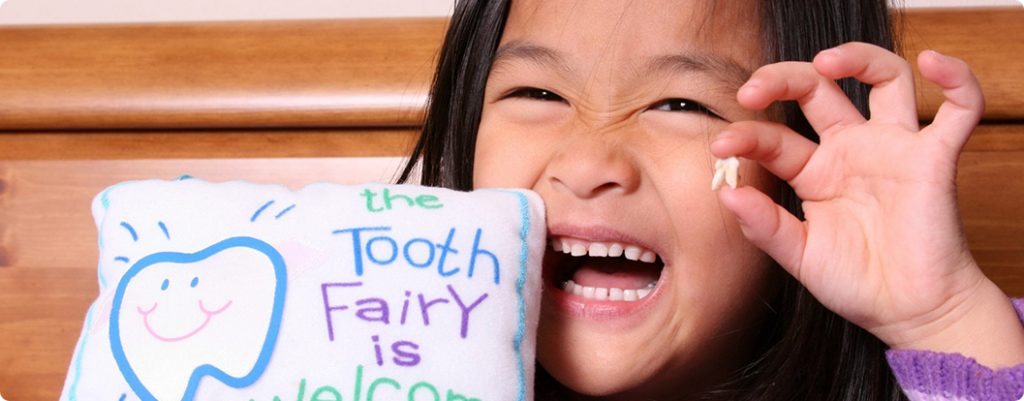Congratulations, Mom and Dad. You have diligently watched over your child as his or her mouth produced all 20 perfect little baby teeth. You followed all the helpful advice while your helpless babe struggled through the pain and discomfort of teething. Now, having barely recovered from that trauma, you get to witness each one of those hard-won battles falling out of your kid’s mouth! Not only will you celebrate with your son or daughter and encourage the removal of each incisor and molar that caused you countless sleepless nights, but you will also pay your child for this act of nature. Don your wings and grab your wand, parent. It’s time to become the tooth fairy!
Having spent the first few years of your child’s life waiting for these teeth to arrive, you may not have thought about having a plan for their impending departure. Never fear; we at FlutterPop are the experts on all things tooth fairy, and we are here to set you up for success. Follow these 6 simple tooth fairy rules for smooth sailing through your child’s tooth loss journey.
1 – Create your plan before the first lost tooth.
You know your child will most likely lose his or her first tooth between ages 5 and 7, but it could happen at a moment’s notice. Figure out your Tooth Fairy strategy before your child loses the first tooth and stick to it through all 20 teeth, then do the same for all your children. By following this very first tooth fairy rule, you’ll eliminate sibling rivalry over differential treatment and most of the frustration that comes from forgetting how to do the job.
2 – Decide on the prize, and keep it on hand.
Remember that the reward you choose has to be replicated 20 times per child. Make sure you don’t accidentally raid college savings funds to fund tooth fairy visits! While Delta Dental’s Original Tooth Fairy Poll® found that American children receive an average of $3.70 per tooth, amounts will vary by region. Talk to the parents of your kids’ friends, especially those with older siblings, to find out the local going rate. (If they are way out of your price range, this would be a good time to find new friends for your kids!) Maybe you’ve already decided to reward with a treat or gift instead of cash. Make sure you can purchase all 20 of those gifts now so that you are never empty-handed at go time. Even if you are giving cash, keep enough on hand to get through the first mouthful. If you’re stuck for ideas, subscribe to our mailing list to get all the latest news on creative tooth fairy treats.
3 – Be practical about tooth drop protocol.
Long gone are the days of sneaking into a child’s dark room, navigating treacherous pitfalls like sharp plastic toys and wayward furniture, and sliding an undetected hand under the pillow to fish out a bare, lone tooth. A cruise through our shop will update you on all the current tooth fairy rules regarding tooth exchange devices. There are pillows, boxes, and charms all decked out in Tooth Fairy summoning decorations. Make sure to find something that comes in enough styles to suit each of your children. Once you have your tooth holder, set the drop site. If your child insists on keeping the tooth near his or her bed, place it on a bedpost or nightstand to avoid waking anyone. Otherwise, leave it on the dresser, or even in the bathroom by the toothbrushes.
4 – Set a reminder, and then set another one.
Being a good tooth fairy is all about doing the job right every time. Once you know about a lost tooth, set an alarm to make sure you exchange the tooth for the reward. If you are prone to falling asleep on the couch or emptying your brain of all adult responsibilities once the kids are in bed, maybe set two alarms. Send yourself a text message. Have a friend or relative text you at an appointed time. Maybe arrange to have a local phone service call you with a reminder. Getting the idea? Consistency is key in being a tooth fairy rule follower.
5 – Have a contingency plan.
You forgot. The tooth didn’t make it home from school. You didn’t know the tooth came out. It happens to the best of us. What’s important is how you recover. Create a few inclement weather, fairy convention, or time zone mix-up excuses that a repentant tooth fairy can issue first thing in the morning. Make sure you set plenty of reminders for the rescheduled reward date and follow through!
6 – Decide what to do with the teeth.
With tooth containers, you’ll have a keepsake that tracks each tooth for each child. Some parents are understandably a bit unnerved about keeping detached teeth and decide to throw them away. Whatever you choose, make sure to do the same thing for each child. We all know about the baby book you made for your oldest, but not the others. Tooth fairy rules clearly state that all children must be treated equally for purposes of tooth posterity.
There you have it, 6 simple tooth fairy rules for holding onto your child’s sense of wonder and magic, even as he or she passes through this phase of growing up before your eyes. If you’re excited about transitioning the Tooth Fairy’s job into the digital age, sign up for our email list and follow us on Facebook and Instagram for progress on the FlutterPop website. We are working hard on our tooth tracking technology to keep your wings fresh and fluttering for years to come!





